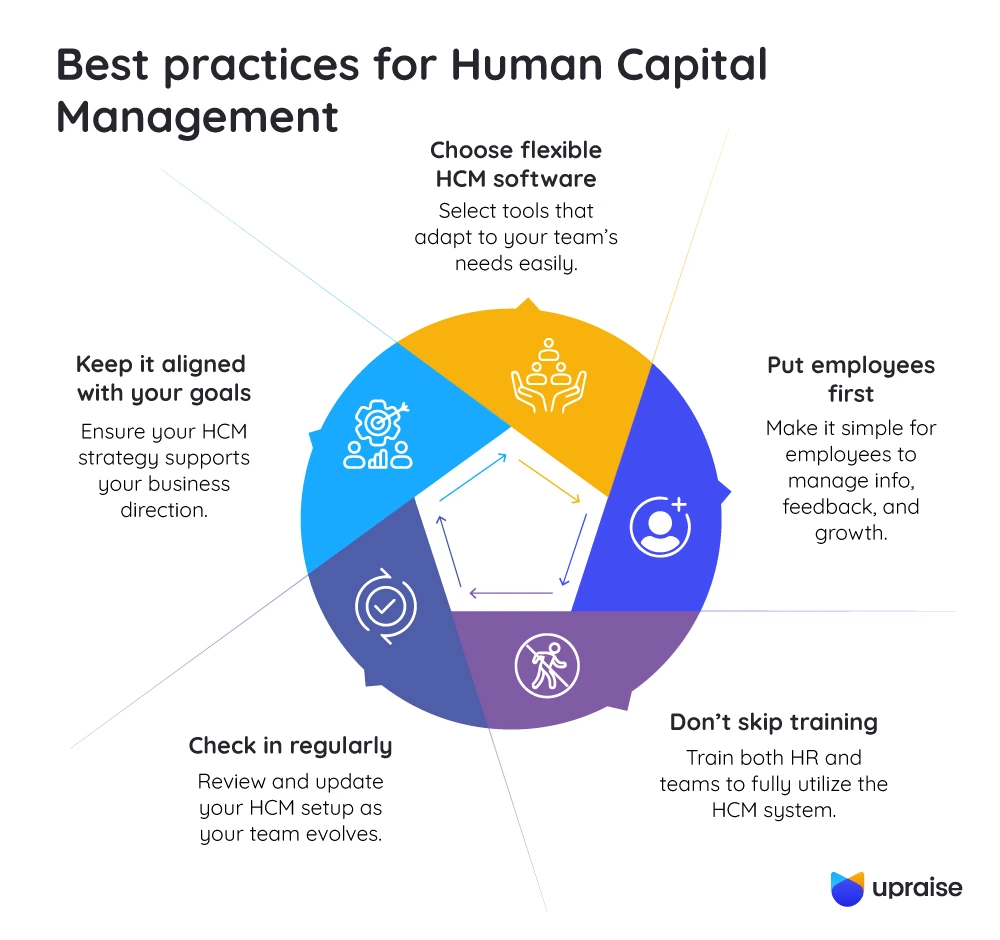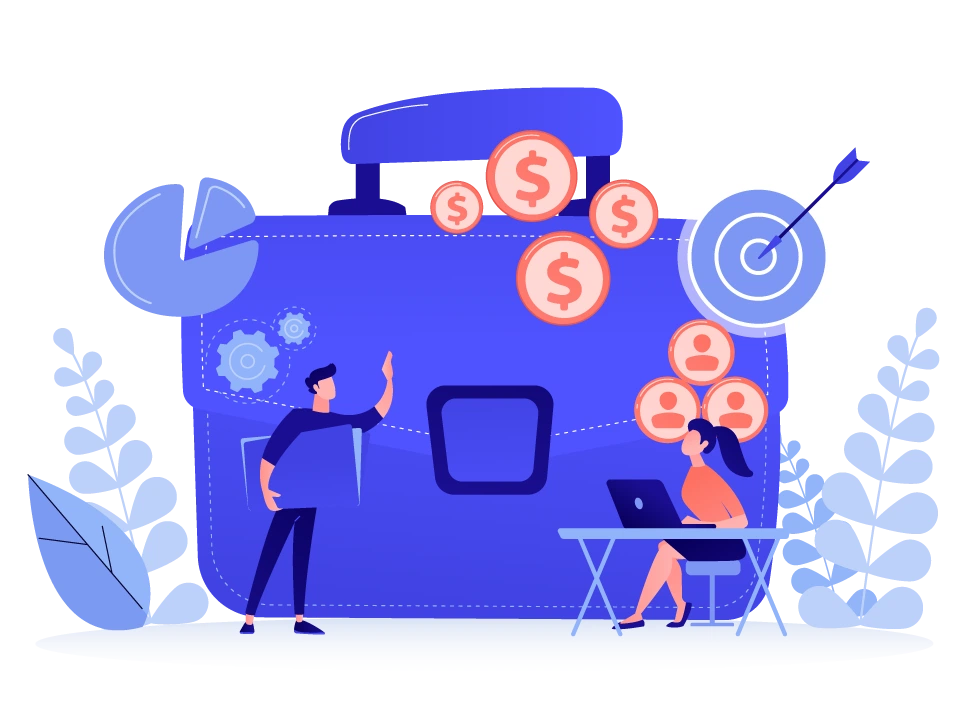Attracting and retaining top talent is harder than ever. Can you relate? Intense competition, evolving employee expectations and widening skill gaps make building strong, stable teams difficult. Poor onboarding or limited growth opportunities can drive them away even when you hire top performers. This is where Human Capital Management (HCM) becomes essential.
So what is Human Capital Management? It goes beyond traditional HR by aligning people strategies with long-term business goals. From recruitment and training to performance and workforce planning, HCM empowers organizations to optimize employee potential and drive long-term success.
In this article, we’ll explore HCM’s meaning, its key components, and how to implement it effectively. We’ll also explore how it can help improve recruitment, development and retention through a structured, people-first approach.
What is Human Capital Management (HCM)?
Human Capital Management (HCM) is a comprehensive approach to managing a company’s workforce. It includes processes like talent acquisition, employee development, performance management, payroll and workforce planning. Unlike traditional HR functions, HCM focuses on optimizing the value employees bring to the organization and vice versa.
HCM’s meaning is rooted in treating people as key business assets. A strong HCM strategy helps align workforce planning with long-term business goals, benefitting both the employer and the employee.
Today, many organizations use HCM software solutions to automate routine tasks, track employee data and improve decision-making. These tools support better recruitment, engagement and retention by offering a structured, data-driven approach to managing people.
How HCM differs from HRM (Human Resource Management)
While often used interchangeably, Human Capital Management (HCM) and Human Resource Management (HRM) are very different. Here is a table highlighting these differences:
| Aspect | Human Resource Management | Human Capital Management |
| Scope and Approach | Narrow, administrative, and reactive — focuses on daily HR tasks like payroll and compliance | Broad, strategic, and proactive — manages the entire employee lifecycle and future workforce needs |
| Technology and Analytics | Uses standalone systems with minimal data use. For example: An HRM system may use separate Excel sheets for attendance and a standalone payroll system with no data integration. | Uses integrated platforms, analytics, and predictive tools for strategic decision-making. For example an HCM would use an integrated platform that links attendance, payroll, performance, and learning data for real-time insights. |
| Talent and Development | Handles hiring, basic training, and compliance | Focuses on talent strategy, leadership development, and continuous learning |
| Value Orientation | Transactional and process-driven, with HR as a support function | Transformational and business-driven, positioning HR as a key contributor to growth |
| Alignment with Business | HR goals are often departmental and operational | Workforce planning in HCM aligns with overall business goals and leadership strategy |
HCM software solutions empower organizations to turn workforce data into strategic insight. By enabling smarter planning and personalized development at scale, it helps HR evolve from an administrative function into a key driver of business success.
Key components of HCM
Understanding what is Human Capital Management means recognizing the core components that make it effective. At its foundation, HCM brings together various strategic functions that help manage and grow an organization’s workforce. Some of its key components include:
- Talent acquisition – Attracting the right candidates through targeted recruitment strategies and leveraging HCM software solutions to improve hiring.
- Onboarding and training – Ensuring new hires are effectively integrated and can access continuous learning opportunities.
- Performance management – Tracking and helping improve employee performance with clear KPIs, regular feedback and goal alignment.
- Workforce planning – Anticipating future hiring needs and developing plans to meet business objectives.
- Employee engagement and retention – Using HCM tools to monitor satisfaction, reduce turnover and build loyalty.
- Succession planning – Identifying and preparing future leaders to ensure business continuity.
By integrating these key elements, HCM empowers businesses to build agile, future-ready teams that can adapt, perform and thrive in a constantly evolving and competitive workforce landscape.
Benefits of Human Capital Management
HCM has many benefits, including improved workforce planning, streamlined HR operations and better alignment between employee performance and business goals. By centralizing key functions such as recruitment, payroll, performance tracking and learning, Human Capital Management empowers you to operate more efficiently and strategically.
Some of the core advantages of Human Capital Management include:
- Better talent acquisition and retention: HCM’S data-driven recruitment strategies and structured onboarding processes enable you to attract the right candidates. It also helps improve employee engagement and satisfaction, which leads to higher retention rates.
- Improved performance management: With clear goal-setting tools and continuous feedback systems that HCM offers, you can track, evaluate and enhance employee performance.
- Centralized workforce data: HCM helps centralize employee information, simplifying data access for HR professionals and helping in better decision-making.
- Regulatory compliance and risk reduction: With automated updates and standardized documentation, HCM helps you stay compliant with ever-changing labor laws and regulations, reducing the risk of human error.
- Support for learning and development: HCM systems often include tools for training, upskilling and professional development, ensuring employees evolve along with business needs.
- Greater operational efficiency: HCM systems streamline routine HR tasks such as payroll, time tracking and benefits administration. This reduces administrative overhead and allows you to focus on more strategic initiatives for your organization.
- Enhanced employee experience: HCM platforms improve employee experience by giving them tools to help manage their details and growth.
For example, an employee can use a mobile app to apply for leave, check payslips, or enroll in a training course — all without needing to contact HR.
With all these benefits, we can say that when supported by the right software, HCM becomes a catalyst for growth, efficiency and long-term success.
How to implement HCM in your organization
Implementing Human Capital Management (HCM) doesn’t have to be complicated. We have broken down this process into seven simple steps:
- Set clear objectives: Define your expectations and set clear goals that you want to achieve with HCM, such as better hiring, performance tracking, employee engagement, etc.
- Audit your current HR system: Identify the gaps in your current process and what features you need in a Human Capital Management software to fill those gaps.
- Choose the right HCM software solution: Pick an HCM software that fits your company’s size, goals and integration needs. You could explore integrated tools that combine payroll, recruitment, performance, and training into one system.
- Involve key stakeholders: Inform, involve and brainstorm with the HR team, leadership and IT department to ensure smooth implementation and adoption of the new Human Capital Management software.
- Plan data migration: Ensure the new system integrates well with existing tools and plans for a secure, accurate migration of employee data.
- Train your team: Make sure your HR team and employees know how to use the new system effectively with guided onboarding and support.
- Track progress: Once implemented, regularly assess how well the system meets your objectives. Use built-in analytics and feedback to continuously improve your HCM approach.
By following these steps, you will be able to surely implement Human Capital Management the right way — maximizing efficiency and employee satisfaction while aligning with business goals.
Best practices for Human Capital Management
Over time, Human Capital Management works best when it’s treated as an ongoing strategy, not just a one-time setup. Here are a few best practices that can help you do this:

- Keep it aligned with your goals: Your HCM approach should support where your business is headed. That’s really the core of what Human Capital Management is about.
- Choose flexible HCM software: Go for a tool that fits your team — not the other way around. The best HCM software solutions simplify your processes, not complicate them.
- Put employees first: Make it easy for people to access their info, give feedback and grow. A good Human Capital Management software should help with that.
- Don’t skip training: People need to know how to use the system — both HR and the rest of your team so your team can make the best out of these software solutions.
- Check in regularly: What works today might not work the following year. Review your setup often and adjust to the growing needs as your team grows.
Keeping it simple and people-focused is key. That’s the real HCM meaning — supporting your team in a smart, structured way.
Conclusion
At the end of the day, Human Capital Management is all about putting people first — and doing it with purpose. From attracting top talent to keeping your teams engaged, skilled and aligned with your business goals, HCM gives you the structure to build a stronger, future-ready workforce.
When you treat HCM as a long-term strategy (and not just another HR process), everything starts to work better — hiring gets easier, performance becomes trackable and employees feel more supported. That’s the real value of Human Capital Management.
A well-designed HCM platform can help you streamline performance, manage talent, and grow with confidence.
FAQs:
How does Human Capital Management (HCM) impact employee retention?
Human Capital Management (HCM) improves employee retention. They can do so by using tools like structured onboarding, training programs, performance tracking and engagement surveys to support employee growth and satisfaction.
What is the role of HCM in employee development and career growth?
HCM plays a key role in employee development and career growth by offering structured learning paths, upskilling opportunities, performance reviews and succession planning. It helps employees grow with the business while staying aligned with its goals.
How can HCM help businesses manage talent in a global workforce?
HCM helps businesses manage talent in a global workforce. Key factors are by centralizing employee data, standardizing HR processes across regions, supporting multi-language and compliance needs and enabling remote training and collaboration.
What are the challenges businesses face when implementing HCM systems?
Implementing HCM systems can be challenging due to high upfront costs and integration complexities with existing tools. Other challenges include resistance to change from employees, data migration difficulties and the need for extensive training to ensure smooth adoption across the organization.




